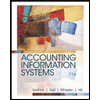
Intermediate Accounting
9th Edition
ISBN: 9781259722660
Author: J. David Spiceland, Mark W. Nelson, Wayne M Thomas
Publisher: McGraw-Hill Education
expand_more
expand_more
format_list_bulleted
Question
Chapter 5, Problem 5.12BYP
To determine
Revenue recognized point of long term contract
A long-term contract qualifies for revenue recognition over time. The seller can recognize the revenue as per percentage of the completion of the project, which is recognized as revenue minus cost of completion until date.
If a contract does not meet the performance obligation norm, then the seller cannot recognize the revenue till the project is complete.
The revenue recognition principle
The revenue recognition principle refers to the revenue that should be recognized in the time period, when the performance obligation (sales or services) of the company is completed.
To discuss: The arguments made by both students, and explain which argument should be supportable.
Expert Solution & Answer
Want to see the full answer?
Check out a sample textbook solution
Students have asked these similar questions
Jassi Company has liabilities equal to one-fourth of the total assets. Jassi's stockholders' equity is $45,000. Using the accounting equation, what is the amount of liabilities for Jassi?
Find out
I don't need ai answer general accounting question
Chapter 5 Solutions
Intermediate Accounting
Ch. 5 - What are the five key steps a company follows to...Ch. 5 - What indicators suggest that a performance...Ch. 5 - What criteria determine whether a company can...Ch. 5 - We recognize service revenue either at one point...Ch. 5 - What characteristics make a good or service a...Ch. 5 - Prob. 5.6QCh. 5 - What must a contract include for the contract to...Ch. 5 - How might the definition of probable affect...Ch. 5 - When a contract includes an option to buy...Ch. 5 - Prob. 5.10Q
Ch. 5 - Prob. 5.11QCh. 5 - Is a customers right to return merchandise a...Ch. 5 - Prob. 5.13QCh. 5 - Under what circumstances should sellers consider...Ch. 5 - When should a seller view a payment to its...Ch. 5 - What are three methods for estimating stand-alone...Ch. 5 - When is revenue recognized with respect to...Ch. 5 - In a franchise arrangement, what are a franchisors...Ch. 5 - When does a company typically recognize revenue...Ch. 5 - Prob. 5.20QCh. 5 - Prob. 5.21QCh. 5 - Prob. 5.22QCh. 5 - Must bad debt expense be reported on its own line...Ch. 5 - Explain the difference between contract assets,...Ch. 5 - Explain how to account for revenue on a long-term...Ch. 5 - Prob. 5.26QCh. 5 - Prob. 5.27QCh. 5 - What are the two general criteria that must be...Ch. 5 - Explain why, in most cases, a seller recognizes...Ch. 5 - Revenue recognition for most installment sales...Ch. 5 - Prob. 5.31QCh. 5 - How does a company report deferred gross profit...Ch. 5 - Prob. 5.33QCh. 5 - Briefly describe the guidelines for recognizing...Ch. 5 - Prob. 5.35QCh. 5 - Briefly describe the guidelines provided by GAAP...Ch. 5 - Revenue recognition at a point in time LO52 On...Ch. 5 - Timing of revenue recognition LO53 Estate...Ch. 5 - Prob. 5.3BECh. 5 - Allocating the transaction price LO54 Sarjit...Ch. 5 - Existence of a contract LO5-5 Tulane Tires wrote...Ch. 5 - Prob. 5.6BECh. 5 - Prob. 5.7BECh. 5 - Performance obligations; warranties LO55 Vroom...Ch. 5 - Prob. 5.9BECh. 5 - Prob. 5.10BECh. 5 - Performance obligations; construction LO55...Ch. 5 - Prob. 5.12BECh. 5 - Prob. 5.13BECh. 5 - Variable consideration LO56 Leo Consulting enters...Ch. 5 - Variable consideration LO56 In January 2018,...Ch. 5 - Prob. 5.16BECh. 5 - Prob. 5.17BECh. 5 - Payment s by the seller to the customer LO56...Ch. 5 - Estimating stand-alone selling prices: adjusted...Ch. 5 - Estimating stand-alone selling prices: expected...Ch. 5 - Estimating stand-alone selling prices; residual...Ch. 5 - Timing of revenue recognition; licenses LO57 Saar...Ch. 5 - Prob. 5.23BECh. 5 - Prob. 5.24BECh. 5 - Timing of revenue recognition; franchises LO57...Ch. 5 - Timing of revenue recognition; bill-and-hold LO57...Ch. 5 - Prob. 5.27BECh. 5 - Prob. 5.28BECh. 5 - Contract assets and contract liabilities LO58...Ch. 5 - Prob. 5.30BECh. 5 - Long-term contract; revenue recognition over time;...Ch. 5 - Prob. 5.32BECh. 5 - Long-term contract; revenue recognition upon...Ch. 5 - Long-term contract; revenue recognition; loss on...Ch. 5 - Installment sales method On July 1, 2018, Apache...Ch. 5 - Prob. 5.36BECh. 5 - Cost recovery method Refer to the situation...Ch. 5 - Prob. 5.38BECh. 5 - Prob. 5.39BECh. 5 - Revenue recognition; software contracts under IFRS...Ch. 5 - Prob. 5.41BECh. 5 - Prob. 5.1ECh. 5 - Prob. 5.2ECh. 5 - Allocating transaction price LO54 Video Planet...Ch. 5 - Prob. 5.4ECh. 5 - Prob. 5.5ECh. 5 - Prob. 5.6ECh. 5 - Prob. 5.7ECh. 5 - Prob. 5.8ECh. 5 - Prob. 5.9ECh. 5 - Variable considerationmost likely amount; change...Ch. 5 - Variable considerationexpected value; change in...Ch. 5 - Prob. 5.12ECh. 5 - Approaches for estimating stand-alone selling...Ch. 5 - FASB codification research LO56, LO57 Access the...Ch. 5 - Franchises; residual method LO56, LO57 Monitor...Ch. 5 - FASB codification research LO58 Access the FASB...Ch. 5 - Long-term contract; revenue recognition over time...Ch. 5 - Long-term contract; revenue recognition over time...Ch. 5 - Long-term contract; revenue recognition over time;...Ch. 5 - Long-term contract; revenue recognition upon...Ch. 5 - Income (loss) recognition; Long-term contract;...Ch. 5 - Long-term contract; revenue recognition over time;...Ch. 5 - Installment sales method Charter Corporation,...Ch. 5 - Installment sales method; journal entries [This is...Ch. 5 - Installment sales; alternative recognition methods...Ch. 5 - Journal entries; point of delivery, installment...Ch. 5 - Prob. 5.27ECh. 5 - Prob. 5.28ECh. 5 - Prob. 5.29ECh. 5 - Prob. 5.30ECh. 5 - Prob. 5.31ECh. 5 - Prob. 5.32ECh. 5 - Prob. 5.33ECh. 5 - Prob. 5.34ECh. 5 - Prob. 5.35ECh. 5 - Prob. 5.1PCh. 5 - Prob. 5.2PCh. 5 - Prob. 5.3PCh. 5 - Prob. 5.4PCh. 5 - Prob. 5.5PCh. 5 - Variable consideration; change of estimate LO53,...Ch. 5 - Prob. 5.7PCh. 5 - Prob. 5.8PCh. 5 - Prob. 5.9PCh. 5 - Long-term contract; revenue recognition over time ...Ch. 5 - Long-term contract; revenue recognition upon...Ch. 5 - Long-term contract; revenue recognized over time;...Ch. 5 - Long-term contract; revenue recognition over time...Ch. 5 - Income statement presentation; installment sales...Ch. 5 - Prob. 5.15PCh. 5 - Installment sales; alternative recognition methods...Ch. 5 - Installment sales and cost recovery methods...Ch. 5 - Prob. 5.18PCh. 5 - Franchise sales; installment sales method Olive...Ch. 5 - Prob. 5.1BYPCh. 5 - Judgment Case 52 Satisfaction of performance...Ch. 5 - Judgment Case 53 Satisfaction of performance...Ch. 5 - Prob. 5.4BYPCh. 5 - Prob. 5.5BYPCh. 5 - Prob. 5.6BYPCh. 5 - Prob. 5.8BYPCh. 5 - Prob. 5.9BYPCh. 5 - Prob. 5.10BYPCh. 5 - Prob. 5.11BYPCh. 5 - Prob. 5.12BYPCh. 5 - Prob. 5.13BYPCh. 5 - Prob. 5.14BYPCh. 5 - Prob. 5.15BYPCh. 5 - Prob. 5.16BYPCh. 5 - Prob. 5.19BYPCh. 5 - Prob. 1CCTC
Knowledge Booster
Similar questions
- Under which method of inventory accounting are the most recent inventory costs matched with current revenues?a) LIFO (Last-In, First-Out)b) FIFO (First-In, First-Out)c) Average Cost Methodd) Specific Identification Methodarrow_forwardWhat is the goal of cost accounting? Explain itarrow_forwardTwo parts of this probarrow_forward
arrow_back_ios
SEE MORE QUESTIONS
arrow_forward_ios
Recommended textbooks for you
 Financial & Managerial AccountingAccountingISBN:9781337119207Author:Carl Warren, James M. Reeve, Jonathan DuchacPublisher:Cengage Learning
Financial & Managerial AccountingAccountingISBN:9781337119207Author:Carl Warren, James M. Reeve, Jonathan DuchacPublisher:Cengage Learning Auditing: A Risk Based-Approach to Conducting a Q...AccountingISBN:9781305080577Author:Karla M Johnstone, Audrey A. Gramling, Larry E. RittenbergPublisher:South-Western College Pub
Auditing: A Risk Based-Approach to Conducting a Q...AccountingISBN:9781305080577Author:Karla M Johnstone, Audrey A. Gramling, Larry E. RittenbergPublisher:South-Western College Pub Corporate Financial AccountingAccountingISBN:9781337398169Author:Carl Warren, Jeff JonesPublisher:Cengage Learning
Corporate Financial AccountingAccountingISBN:9781337398169Author:Carl Warren, Jeff JonesPublisher:Cengage Learning AccountingAccountingISBN:9781337272094Author:WARREN, Carl S., Reeve, James M., Duchac, Jonathan E.Publisher:Cengage Learning,
AccountingAccountingISBN:9781337272094Author:WARREN, Carl S., Reeve, James M., Duchac, Jonathan E.Publisher:Cengage Learning, Accounting Information SystemsFinanceISBN:9781337552127Author:Ulric J. Gelinas, Richard B. Dull, Patrick Wheeler, Mary Callahan HillPublisher:Cengage Learning
Accounting Information SystemsFinanceISBN:9781337552127Author:Ulric J. Gelinas, Richard B. Dull, Patrick Wheeler, Mary Callahan HillPublisher:Cengage Learning

Financial & Managerial Accounting
Accounting
ISBN:9781337119207
Author:Carl Warren, James M. Reeve, Jonathan Duchac
Publisher:Cengage Learning

Auditing: A Risk Based-Approach to Conducting a Q...
Accounting
ISBN:9781305080577
Author:Karla M Johnstone, Audrey A. Gramling, Larry E. Rittenberg
Publisher:South-Western College Pub

Corporate Financial Accounting
Accounting
ISBN:9781337398169
Author:Carl Warren, Jeff Jones
Publisher:Cengage Learning

Accounting
Accounting
ISBN:9781337272094
Author:WARREN, Carl S., Reeve, James M., Duchac, Jonathan E.
Publisher:Cengage Learning,

Accounting Information Systems
Finance
ISBN:9781337552127
Author:Ulric J. Gelinas, Richard B. Dull, Patrick Wheeler, Mary Callahan Hill
Publisher:Cengage Learning
